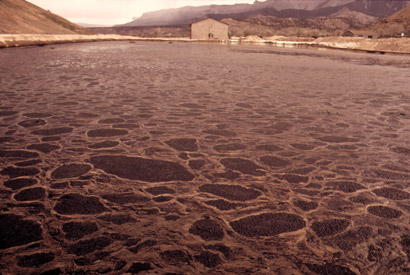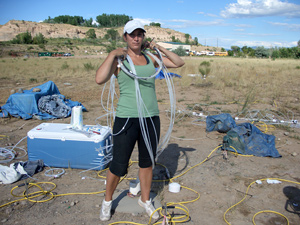Contaminated site yields wealth of information on microbes 10 feet under
UC Berkeley scientists have sequenced nearly all the genes in an underground community of microbes at a contaminated uranium mill site in Rifle, Colo. Their work provides information that could help scientists better manipulate microbes that remediate heavy-metal contamination, or those that take up and store carbon from the atmosphere.

September 27, 2012
Naturally occurring bacteria in the Gulf of Mexico did a great job helping to clean up 2010’s huge Deepwater Horizon oil spill, but bacteria can do even heavier lifting. Routinely used to help clean up toxic metals at contaminated sites, bacteria and other soil microbes are fed to boost their ability to turn soluble metals into solids that won’t leach into streams or aquifers.
UC Berkeley scientists have now dug into the soil of one of these heavy metal contaminated sites to analyze the genes of the underground microbial community in hopes of finding ways to help improve the microbes’ ability to remediate toxic metal contamination.
In this week’s issue of the journal Science, Jill Banfield, Kelly Wrighton and their colleagues report the sequencing of nearly 150,000 genes from soil samples at a former uranium mill site along the Colorado River in Rifle, Colo. They were able to assign most of the genes to 80 separate microbes – bacteria and Archaea – plus a few viruses.
What they learn could also lead to improved methods for stimulating the uptake of carbon from the atmosphere by soil bacteria to reduce greenhouse gases.

Post-doc Kelly Wrighton among the equipment she used to extract microbes from underground at the contaminated site in Rifle.
“In order to make this goal a reality, it is critical not to just detect the relevant genes in subsurface microorganisms, but to know enough about the lifestyles of the organisms with genes of interest so that manipulation of the system enriches specifically for that organism,” said Banfield, UC Berkeley professor of earth and planetary science and of environmental science, policy and management.
It may be possible, for example, to add nutrients that would create the ideal mix of microbes to immobilize the metals, instead of just feeding all the microbes already present.
“Our study turned upside down what we thought was happening at the bioremediation site,” said Wrighton, lead author and UC Berkeley post-doctoral fellow who specializes in the physiology of microbes. “What these genomes have given us is amazing in terms of being able to look under the hood at the machine of these organisms that we never really knew anything about, except that we saw them in certain types of environments.”
The “dark matter” of biology
The microbes came from groundwater samples taken at a site once used to process vanadium and, during and after World War II, uranium. The site borders the Colorado River, which means that rain can carry dissolved metals into the groundwater and eventually into the river. Some microbes “breathe” the metals like we breathe oxygen, chemically altering them so they become insoluble and remain in the sediment, Wrighton said.
Banfield refers to microbe communities like these as the “dark matter” of biology, an analogy to the missing mass in the universe that has stumped astronomers for decades. The bacterial tree of life can be divided into about 60 phylum-level branches, but essentially nothing is known about half of them, she said.
“This new study provides new knowledge about the ecology as well as the evolution of a significant chunk of what could be considered the dark matter of the microbial world,” she said.
Before now, Banfield had performed metagenomic analyses of eight microbes coexisting in highly acidic underground streams in a former California mine and current Superfund clean-up site. Such an analysis involves grinding up all organisms in a sample, sequencing all the genes and then matching each with a unique microbial species.

Drilling underway at the Rifle site.
The new study involved the genomes of 10 times more organisms. All are anaerobic – they don’t breathe oxygen like most organisms on Earth – and most, while not new to science, are totally unstudied because they cannot be cultured in the laboratory. Many are only a few hundred nanometers across, making them among the smallest known microbes.
Scientists at the Rifle site spread acetate – essentially diluted vinegar – in the subsurface to feed the underground bacteria that convert soluble metals to insoluble metals. They had assumed that they were culturing a colony comprised mostly of Geobacter bemidjiensis, a well-known metal-reducing bacterium.
Instead, Wrighton said, analysis of three samples obtained within 10 days of acetate application showed a healthy population of Geobacter, but a throng of other bacteria presumably feeding on dead Geobacter and other carbon in the soil from previous additions of acetate. These organisms use or ferment complex carbon, such as dead plants and dead microbes, and produce hydrogen, small organic carbon compounds and carbon dioxide.
“The fermenters producing hydrogen after multiple additions of acetate may be more important to the underlying microbial community than we once thought,” said Philip E. Long, an LBNL geologist who manages research at the Rifle study site.
Wrighton, Banfield and their team are continuing metagenomic analyses of samples from the Rifle site, including some obtained before nutrients are added to determine what the natural population looks like.
The work was funded by the U.S. Department of Energy’s Biological and Environmental Research program. Coauthors of the paper include Brian C. Thomas, Itai Sharon and Christopher S. Miller of UC Berkeley; Long, Cindy J. Castelle and Kenneth H. Williams of LBNL; Nathan C. VerBerkmoes and Robert L. Hettich of Oak Ridge National Laboratory; and Michael J. Wilkins and Mary S. Lipton of Pacific Northwest National Laboratory.
RELATED INFORMATION